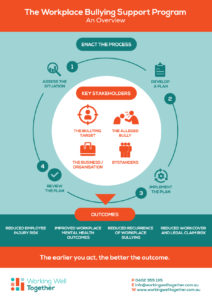One of the first steps we are told when there is a bullying allegation, whether in HR or as a general manager, is to investigate the matter. The message is to investigate, even if the employee doesn’t want it to be undertaken. That’s an understandable approach. It establishes if the bullying problem exists in the first place. It covers off liability.
However, I see an underlying flaw in this logic; and this flaw places both the target and your company or organisation at risk.
Your first priority is to assess and identify whether there a risk that an investigation will exacerbate a mental health injury to that employee. If there is, your first priority is to ensure that employee’s safety through provision of appropriate support.
Bullying is complex. So is trauma.
I have written before about the link between workplace bullying, trauma and suicide. Research has indicated that 57% of bullied employees are likely to have post-traumatic stress disorder symptoms. This has significant implications for our workplace bullying first responses.
In simple terms, our brain is comprised of two parts; the left and right hemisphere. The left hemisphere is the logical and analytical side of the brain. The right side of the brain, the emotional, instinctual and intuitive side. When a person is traumatised, the left side of our brain, that which bring reason and situational analysis, shuts down. This leaves the emotional and instinctual side in control.
People who are traumatised commonly experience flashbacks. Scans of the brain of people suffering trauma and in the midst of flashbacks show that, like at the initial time of traumatisation, the left hemisphere shuts down. This research shows that talking about their experience can often lead to the flashbacks. This is regardless of whether it was six months or six years ago if the trauma has been untreated.
Reliving the trauma during bullying investigations
The problem with bullying investigations is that asking a bullied employee who is traumatised to relive the experience is a serious risk to their health and safety risk. An investigation not only asks that person to go and find the evidence that they were bullied, then talk it through in an investigation process that can last weeks. These very acts forcing recall of the experience can lead to flashbacks that contributes to the traumatisation process.
For those suffering from trauma, the flashbacks are more than memories of the past. In their mind, the events are happening to them again at the time of talking about their experience and experiencing the flashbacks about the those events.
Imagine the harm that forcing a traumatised employee into an investigation might do.
On top of that, you are asking a person, who’s logical and analytical side of the brain has shut down, to create a sequence of events that demonstrates they were bullied. It’s not possible. It’s a process, where a traumatised person is involved, that is set up for failure from the start.
Assess first, investigate later
Work health and safety laws asks employers to assess a situation where an employee is at risk of harm or injury and mitigate that risk. It is a step employers often fail in when it comes to workplace bullying.
Our first step is to complete and assessment. Identify if the employee is showing signs of trauma then refer them onto appropriate support. Only if it is identified that it is safe to do so should an investigation proceed.
A word of caution. I often hear the phrase, we referred them onto our Employee Assistance Program (EAP), but we can’t force them to access it. That’s true, you can’t. The question I ask is how proactive were you in getting them to engage in that support?
As stated, those suffering trauma will experience a shutdown of their logical side of the brain. You shouldn’t expect them to act in what might be their own best interests. Sometimes you need to be proactive in facilitating them to access that support. Doing as much as you can to facilitate that referral is a sign of an employer who cares.
It’s time to ask the question. If we know that workplace bullying leads to trauma, and talking about the experience leads further traumatisation, then are workplace bullying investigations where there is no assessment of that injury a negligent act?
Learn more about our Workplace Bullying Support Program
Contact us today for a confidential discussion on how we can help you support you and your employees with bullying claims.
If you or anyone you know needs help:
- Lifeline on 13 11 14
- Kids Helpline on 1800 551 800
- MensLine Australia on 1300 789 978
- Suicide Call Back Service on 1300 659 467
- Beyond Blue on 1300 22 46 36
- Headspace on 1800 650 890
- ReachOut at au.reachout.com


